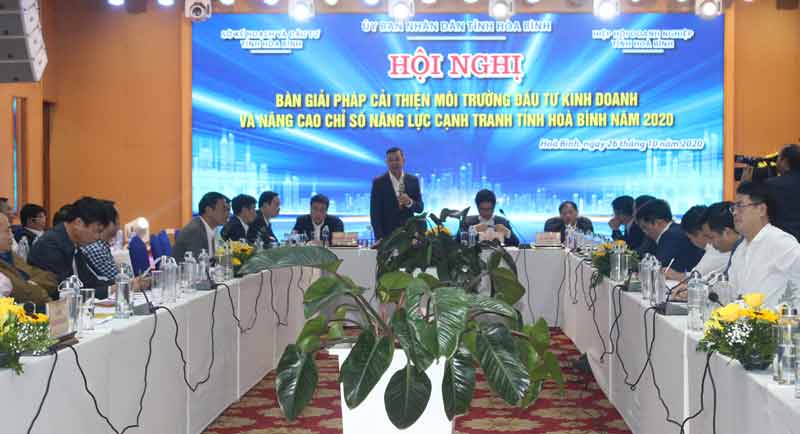
(HBO) – The provincial Business Association held a conference on October 26 to discuss ways improving local business environment and competitiveness index.
 Secretary
of the provincial Party Committee and Honorary Chairman of the provincial
Business Association Ngo Van Tuan addresses the conference.
Secretary
of the provincial Party Committee and Honorary Chairman of the provincial
Business Association Ngo Van Tuan addresses the conference.
In the past nine months, the province drew 35
projects, including two foreign-invested ones with a total registered capital
of over 16.8 trillion VND. As of the late September, there were 589 projects,
including 41 foreign-invested ones, worth more than 99.3 trillion VND. As many
as 275 projects have been put into operation, or 46.7 percent of the total.
In order to improve business environment, the
provincial Party Committee and People's Committee issued a number of documents
directing administrative reform, held meetings and dialogues to clear
difficulties faced by businesses and reform apparatus. However, problems remain
such as excessive, overlapping and sub-standard planning which hampers
investment and development. Administrative procedures regarding land is
considered the leading trouble for firms. Many enterprises find it hard to
access budget documents, land use planning and public investment plan. Access
to information relies on relationship while firms also face burden related to
inspection.
Speaking at the event, President of the Vietnam
Chamber of Commerce and Industry Vu Tien Loc lauded Hoa Binh for its improved
provincial competitiveness index (PCI) last year. He said there remains room
for the province to improve business climate and competitiveness, becoming a
new destination for investment attraction. In the near future, he suggested
enhancing communications to introduce its potential and advantages, especially
in tourism, high-tech agriculture, industry, particularly support industry to
serve the capital and northern key economic zone. He also called for
facilitating firms’ access to transparent information, tackling difficulties
regarding land, taxation and insurance procedures while improving working
efficiency of the local public administration service centre and the role of
business association.
Secretary Tuan said in the near future, the
provincial Party Committee and People’s Committee will drastically direct
planning, improve the working efficiency of one-stop shop mechanism, remove
bottlenecks in land and inspection procedures. Departments, agencies, districts
and city need to assign specific tasks to officers and step up digital transformation
among firms. The business association must raise its sense of responsibility
for assessing PCI and reporting difficulties to provincial leaders./.
According to data from the Hoa Binh Provincial Party Committee, the industrial production index for the first six months of 2025 is estimated to have increased by 20% compared to the same period last year. This marks the highest year-on-year growth rate for this period since 2020.
In the first six months of 2025, Hoa Binh province’s export turnover was estimated at 1.145 billion USD, marking an 18.11% increase compared to the same period in 2024. Import turnover was estimated at $ 804 million, a 17.15% increase, which helped the province maintain a positive trade balance.
The lives of the ethnic minority farmers in Tan Lac district have gradually improved thanks to the new directions in agricultural production. This is a testament to the collective strength fostered through the professional associations and groups implemented by various levels of the district’s Farmers’ Union.
With the motto the "product quality comes first,” after nearly one year of establishment and operation, Muong village’s Clean Food Agricultural and Commercial Cooperative, located in Cau Hamlet, Hung Son Commune (Kim Boi district), has launched reputable, high-quality agricultural products to the market that are well-received by consumers. The products such as Muong village’s pork sausage, salt-cured chicken, and salt-cured pork hocks have gradually carved out a place in the market and they are on the path to obtaining the OCOP certification.
In the past, the phrase "bumper harvest, rock-bottom prices" was a familiar refrain for Vietnamese farmers engaged in fragmented, small-scale agriculture. But today, a new spirit is emerging across rural areas of Hoa Binh province - one of collaboration, organisation, and collective economic models that provide a stable foundation for production.
Maintaining growing area codes and packing facility codes in accordance with regulations is a mandatory requirement for agricultural products to be eligible for export. Recently, the Department of Agriculture and Environment of Hoa Binh province has intensified technical supervision of designated farming areas and packing facilities to safeguard the "green passport" that enables its products to access international markets.



 Secretary
of the provincial Party Committee and Honorary Chairman of the provincial
Business Association Ngo Van Tuan addresses the conference.
Secretary
of the provincial Party Committee and Honorary Chairman of the provincial
Business Association Ngo Van Tuan addresses the conference.